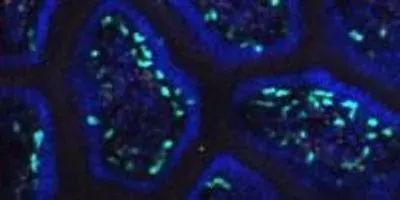 Patrolling the border: New research explains the development of IELs, immune cells that inhabit the thin lining of the intestine. Above, transverse cross sections of the fingerlike villi of the intestine show green IELs within blue epithelial cells that border each villus.Rockefeller UniversityNew research at Rockefeller University sheds light on the development of a unique class of immune cells known as intraepithelial lymphocytes (IELs) that reside in this critical interface. The findings, published August 21 in Immunity, may help lead to new insights into in inflammatory diseases of the gut, including Inflammatory Bowel Disorder and celiac disease, as well as cancer.
Patrolling the border: New research explains the development of IELs, immune cells that inhabit the thin lining of the intestine. Above, transverse cross sections of the fingerlike villi of the intestine show green IELs within blue epithelial cells that border each villus.Rockefeller UniversityNew research at Rockefeller University sheds light on the development of a unique class of immune cells known as intraepithelial lymphocytes (IELs) that reside in this critical interface. The findings, published August 21 in Immunity, may help lead to new insights into in inflammatory diseases of the gut, including Inflammatory Bowel Disorder and celiac disease, as well as cancer.
“IELs can originate directly from an organ known as the thymus, or they are induced from other, fully mature lymphocytes. Our research has uncovered the pathway necessary for the generation of both so-called natural and induced IELs,” says study author Daniel Mucida, assistant professor and head of the Laboratory of Mucosal Immunology. “The discovery of this pathway makes it possible to explore exactly how the IELs protect the gut, which no one has so far been able to address in a conclusive way.”
IELs police the single-cell layer of intestinal epithelium, a fine boundary that spans as much as 400 square meters and allows nutrients in and wastes out. Nearly all IELs belong to a group of lymphocytes (themselves a type of white blood cell) known as T cells, produced by the thymus, an organ below the breastbone.
IELs are made one of two ways. “Natural” IELs require no additional activation after they are produced by the thymus. “Induced” IELs, meanwhile, are produced when two types of mature T cells, CD4 and CD8 cells, acquire new traits and move into the gut epithelium, becoming IELs.
During an immune response, CD4 cells send out signals to other immune cells, earning them the name helper T cells. In research published last year, Mucida and his colleagues uncovered how CD4 cells lose much of their helper function, and take on characteristics more commonly associated with CD8 cells and IELs, which are less likely to promote inflammation.
The new research took a closer look at this pathway, which the team had since determined leads to all IELs, natural and induced. They focused on two proteins, T-bet and Runx3, transcription factors that regulate the expression of genes. Both T-bet and Runx3 occur in high levels in IELs, and were already known to play a role in the development and function of T cells.
“Using genetically modified mice, along with other techniques, we determined the hierarchy between these two transcription factors: T-bet induces the expression of Runx3,” says Bernardo Reis, a postdoc and first author of the study. “By exposing mature T cells from the blood to conditions like those in the gut, we found the gut environment itself may trigger this interplay and lead to the induction of IELs.”
While these IELs, and the pathway leading to them, are crucial to intestinal health, they can sometimes malfunction and contribute to disease. For example, an unbalanced IEL response to gluten may lead to celiac disease, and reduced IEL function can also leave the intestine more vulnerable to infection.
“Now that we understand the IEL pathway and the genes involved, we can design studies that explore in more detail both IELs physiological, protective function and their detrimental side,” Mucida says.
New research at Rockefeller University sheds light on the development of a unique class of immune cells known as intraepithelial lymphocytes (IELs) that reside in this critical interface. The findings, published August 21 in Immunity, may help lead to new insights into in inflammatory diseases of the gut, including Inflammatory Bowel Disorder and celiac disease, as well as cancer.
To continue reading this article, sign up for FREE to

Membership is FREE and provides you with instant access to eNewsletters, digital publications, article archives, and more.












